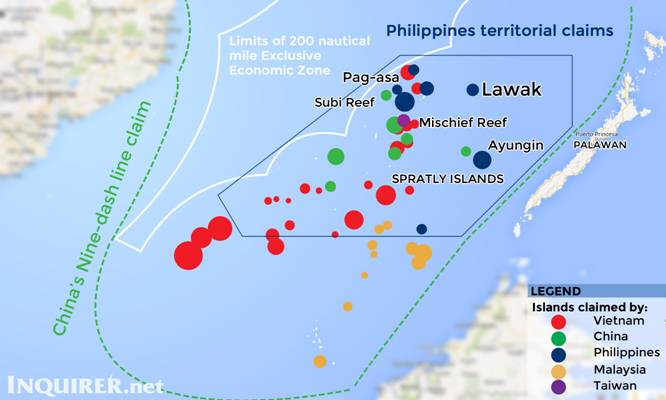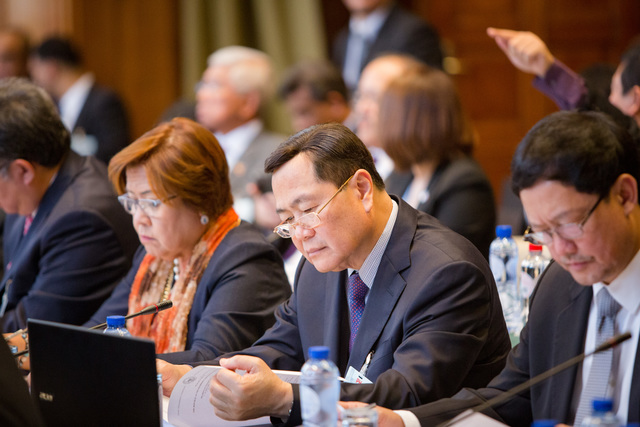
Philippines challenges China's Claim of country's exclusive economic zone at UNCLOS Tribunal in The Hague. image: inquirer.net
IN PHOTOS: Philippines challenges China in The Hague
In photos emailed to Rappler, the Permanent Court of Arbitration gives us a glimpse of the closed-door hearings pitting Manila against Beijing
MANILA, Philippines – Behind closed doors, the Philippines recently waged a legal battle against China in The Hague, Netherlands, in a historic case over the disputed West Philippine Sea (South China Sea).
The Philippines on Thursday, July 23, is set to submit a new document to The Hague to bolster its case.
While Manila pursues this, a question remains: What exactly happened during hearings from July 7 to 13?
The Permanent Court of Arbitration (PCA) in The Hague, which serves as the venue for the arbitration proceedings, emailed Rappler high-resolution photos to give us a glimpse of the closed-door hearings.

China claimed the shores of Vietnam, Philippines, Malaysia, Indonesia, Brunei and Japan as their own
The photos show a powerhouse team, led by internationally acclaimed lawyer Paul Reichler, defending the Philippines' case before an equally high-caliber arbitral tribunal in The Hague.
The tribunal said around 60 members joined the Philippine team. (READ: Binay hits Philippine team vs China in The Hague))
Check out these photos from the Permanent Court of Arbitration (PCA) in The Hague.

TOP DIPLOMAT. Philippine Foreign Secretary Albert del Rosario delivers an opening statement. Photo courtesy of PCA

IN SESSION. Early on, the arbitral tribunal in The Hague decides to hold the hearings behind closed doors. Photo courtesy of PCA

TOP GOVERNMENT LAWYER. Philippine Solicitor General Florin Hilbay, who serves as agent for his country, delivers a statement. Photo courtesy of PCA

TEAM OF EXPERTS. The counsel team for the Philippines, including Professor Bernard Oxman, Professor Alan Boyle, and Mr Lawrence Martin, in the closed-door hearings. Photo courtesy of PCA

HISTORIC CASE. The arbitral tribunal in The Hague, Netherlands, listens to the first country that brought China to court over the West Philippine Sea (South China Sea). Photo courtesy of PCA

'GIANT SLAYER.' Internationally acclaimed lawyer Paul Reichler, the Philippines' chief counsel, delivers a statement. Photo courtesy of PCA

REPRESENTING GOVERNMENT. Members of the Philippine delegation, including Justice Secretary Leila de Lima, Supreme Court Senior Associate Justice Antonio Carpio, and Deputy Executive Secretary for Legal Affairs Menardo Guevarra. Photo courtesy of PCA

OBSERVER DELEGATIONS. The tribunal allowed observers from the following countries – Vietnam, Malaysia, Indonesia, Thailand, and Japan – to attend the hearings. Photo courtesy of PCA

HIGH-CALIBER TRIBUNAL. The arbitral tribunal is led by Judge Thomas Mensah (president, C), the first president of the International Tribunal for the Law of the Sea. The high-caliber tribunal also includes the following (L to R): Judge Jean-Pierre Cot, Judge Stanislaw Pawlak, Judge Rüdiger Wolfrum, and Professor Alfred H. A. Soons. Photo courtesy of PCA

TEAM PHILIPPINES. Representing all 3 branches of Philippine government, the Philippine delegation comes in full force in The Hague. Photo courtesy of PCA
The 5-member tribunal said it "now enters its deliberations" on whether it has the right to hear the Philippines' case. It said it expects to rule on this matter "before the end of the year."
The tribunal said it "is conscious of its duty under the Rules of Procedure to conduct proceedings 'to avoid unnecessary delay and expense and to provide a fair and efficient process.'"
Once the tribunal decides it has jurisdiction over the case, the Philippines can already present the meat of its arguments. (READ: EXPLAINER: Philippines' 5 arguments vs China)
The Philippines said it expects a definitive ruling against China by 2016 – Rappler.com

























